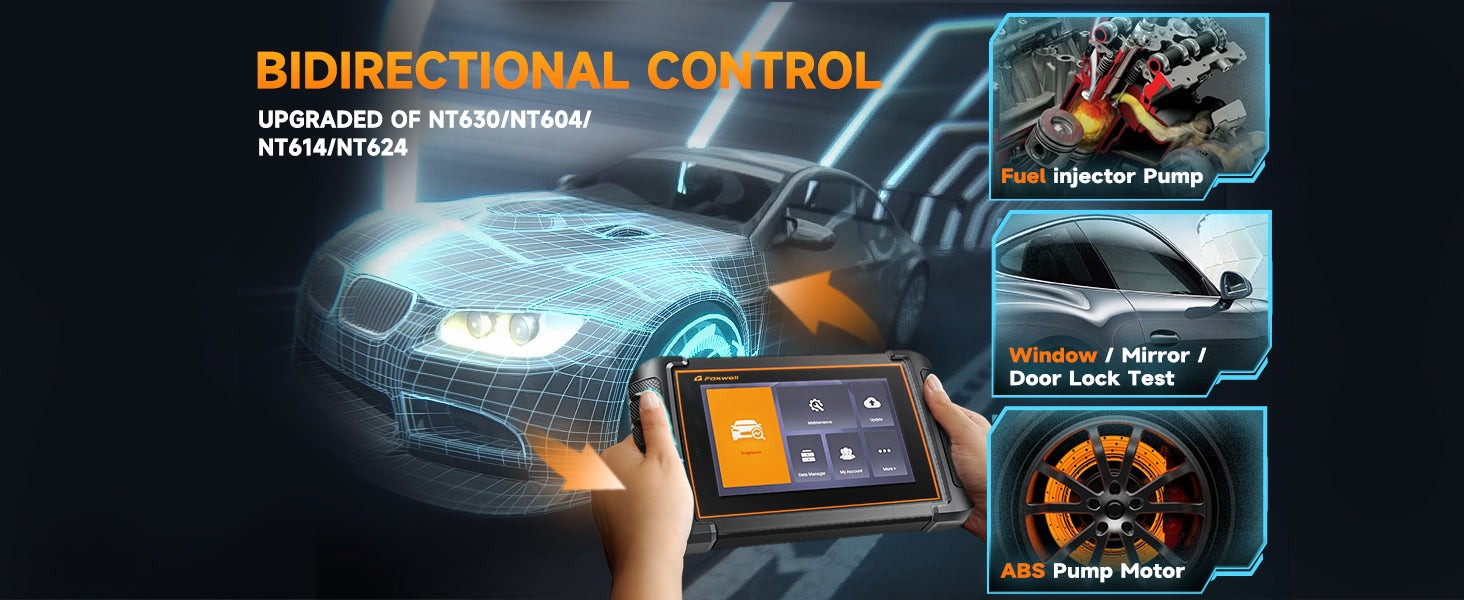Automotive technology is constantly evolving, and two systems stand out for their crucial roles in vehicle maintenance and safety: OBD2 (On-Board Diagnostics II) and TPMS (Tire Pressure Monitoring System). While both are vital for modern vehicles, they serve different purposes. TPMS is specifically designed to monitor tire pressure, directly impacting safety and efficiency, while OBD2 systems offer broader diagnostic capabilities. This article delves into whether you can use a standard OBD2 scanner to reset your TPMS, and when you might need a more specialized tool.
Alt text: A Foxwell bi-directional control scanner displaying diagnostic information, highlighting its advanced capabilities for automotive system checks.
Understanding Tire Pressure Monitoring Systems (TPMS) and Their Importance
A Tire Pressure Monitoring System (TPMS) is an electronic system that constantly monitors the air pressure in your vehicle’s tires. This system transmits real-time tire pressure information to the driver, usually via a dashboard display, a pictogram, or a warning light that illuminates when tire pressure drops below a safe level.
Maintaining correct tire pressure is not just about tire longevity or fuel efficiency; it’s a critical safety aspect. Properly inflated tires are essential for:
- Enhanced Vehicle Handling: Under-inflated tires can significantly impair a vehicle’s handling, making steering less responsive, especially in emergency situations or at higher speeds.
- Reduced Risk of Tire Failure: Insufficient tire pressure leads to increased friction and heat buildup within the tire. This excessive heat can cause tire blowouts, which are extremely dangerous and can lead to accidents.
- Optimized Braking Performance: Correctly inflated tires ensure optimal contact with the road surface, which is crucial for effective braking. Under-inflated tires can increase stopping distances, posing a safety risk, particularly in sudden stop scenarios.
By providing continuous monitoring of tire pressure, TPMS plays a vital role in preventing accidents and improving overall road safety by alerting drivers to potential tire issues before they escalate into serious problems.
A frequent question for vehicle owners and technicians alike is: “Can You Reset Tpms With Obd2 scanners?” To answer this, we need to understand the capabilities of standard OBD2 scanners and why specialized tools are often necessary for TPMS resets.
Understanding OBD2 Scanner Capabilities for TPMS
OBD2 scanners are primarily designed to diagnose engine and emission-related issues. They excel at reading and clearing diagnostic trouble codes (DTCs) related to the engine control unit (ECU) and related systems. While OBD2 systems are standardized across vehicles for basic diagnostics, their capabilities concerning systems like TPMS are often limited.
Limitations of Standard OBD2 Scanners for TPMS Reset
Standard OBD2 scanners offer valuable diagnostic data and can access various vehicle systems, including potentially some TPMS information. However, their capabilities for TPMS are generally restricted to:
- Reading Generic TPMS Codes: Basic OBD2 scanners can often read generic OBD2 codes that might be triggered by TPMS issues. However, these codes are often very general and may not provide specific details needed for accurate diagnosis or reset.
- Limited Reset Functionality: While standard OBD2 scanners are excellent for resetting engine-related codes, they typically cannot reset TPMS directly. TPMS systems often use manufacturer-specific protocols and require more advanced commands than generic OBD2 functions can provide.
- Lack of Sensor Programming or Relearn Functions: Resetting TPMS often involves more than just clearing codes. It may require sensor programming, especially after replacing sensors or rotating tires. Standard OBD2 scanners generally lack the functionality to program new TPMS sensors or initiate the sensor relearn procedure required for the system to recognize new or repositioned sensors.
Therefore, while a standard OBD2 scanner can be a valuable tool for basic vehicle diagnostics, it’s usually not sufficient for resetting TPMS or performing necessary maintenance tasks related to the system.
When Do You Need a Specialized TPMS Reset Tool?
For comprehensive TPMS maintenance, including resetting the system, programming sensors, and performing relearn procedures, specialized TPMS tools are often necessary. Here’s why:
- Manufacturer-Specific Protocols: TPMS modules operate using protocols that are often unique to each vehicle manufacturer. Specialized TPMS scanners are designed to communicate using these proprietary protocols, enabling them to interact effectively with the TPMS module.
- Advanced TPMS Functions: Resetting TPMS frequently involves more than just clearing codes. It can require initiating a sensor relearn procedure after tire rotation or sensor replacement. Specialized tools guide you through these procedures, ensuring the vehicle accurately recognizes all TPMS sensors.
- Sensor Programming Capabilities: When TPMS sensors are replaced, especially with aftermarket sensors, they often need to be programmed with the vehicle’s specific sensor IDs. TPMS-specific tools have the capability to program new sensors, ensuring seamless integration with the vehicle’s TPMS.
- Comprehensive TPMS Diagnostics: Beyond resetting, specialized TPMS tools offer in-depth diagnostic features, such as reading live sensor data (pressure, temperature, battery status), performing sensor health checks, and pinpointing specific issues within the TPMS.
Features of TPMS-Specific Scanners
When choosing a TPMS tool, consider these key features:
- Broad Sensor Compatibility: Ensure the scanner is compatible with a wide range of TPMS sensor brands and vehicle makes and models.
- Sensor Programming Functionality: Crucial for installing new sensors or using aftermarket replacements. The tool should support programming sensor IDs into the TPMS module.
- TPMS Reset and Relearn Procedures: The scanner should guide users through the TPMS reset and sensor relearn procedures efficiently.
- Live Sensor Data Display: The ability to display real-time data from each sensor (pressure, temperature, battery voltage) is invaluable for accurate diagnostics and troubleshooting.
Foxwell Scanners for TPMS Reset: NT310 and NT530
For vehicle owners and technicians seeking reliable TPMS solutions, Foxwell offers several diagnostic tools equipped for effective TPMS management and reset. Two notable models are the Foxwell NT310 and NT530.
Foxwell NT310 TPMS Universal Tool
The Foxwell NT310 is specifically designed for TPMS tasks. It offers features to:
- Trigger TPMS sensors: Activate sensors to read their data.
- Program TPMS sensors: Program new sensor IDs into the TPMS module.
- Perform TPMS relearn procedures: Guide users through the sensor relearn process after tire rotation or sensor replacement.
- Diagnose TPMS faults: Read TPMS diagnostic trouble codes.
The NT310 is designed with a user-friendly interface, making TPMS maintenance straightforward for both DIYers and professionals.
Foxwell NT530 Multi-System Scanner
The Foxwell NT530 is a more versatile multi-system scanner that, in addition to comprehensive vehicle diagnostics across various systems (engine, ABS, airbags, etc.), also includes robust TPMS capabilities. The NT530 offers:
- Comprehensive Vehicle Diagnostics: Full system scans beyond just TPMS.
- Vehicle-Specific Software: Equipped with vehicle-specific software, the NT530 can function like an OEM-level diagnostic tool for various brands, ensuring accurate TPMS resets and diagnostics.
- Advanced Functions: Supports bi-directional tests, allowing users to send commands to vehicle components to perform specific actions, valuable for troubleshooting and verifying repairs.
- TPMS Reset and Programming: Includes features for TPMS reset, sensor programming, and relearn procedures.
Key Features Shared by Foxwell NT310 and NT530 for TPMS:
- Direct TPMS Support: Both scanners provide direct access to the TPMS module for effective monitoring and resetting.
- Extensive Vehicle Coverage: Support a wide range of vehicle makes and models equipped with TPMS.
- Regular Software Updates: Foxwell provides regular updates to ensure compatibility with the latest vehicle models and TPMS technologies.
Alt text: Close-up of a Foxwell car scanner displaying battery voltage, illustrating its ability to monitor vehicle electrical systems in addition to TPMS.
Choosing the Right Scanner for TPMS Reset
In conclusion, while standard OBD2 scanners are essential for general vehicle diagnostics, they typically cannot reset TPMS systems or perform sensor programming and relearn procedures effectively. For comprehensive TPMS maintenance, specialized TPMS tools like the Foxwell NT310 and NT530 are recommended.
- For dedicated TPMS work: The Foxwell NT310 is an excellent choice, offering focused TPMS functionalities with user-friendliness.
- For comprehensive diagnostics including TPMS: The Foxwell NT530 provides broader vehicle system diagnostics, including robust TPMS capabilities, making it a versatile tool for professionals and advanced DIYers.
Ultimately, choosing the right scanner depends on your specific needs and the depth of TPMS maintenance you intend to perform. Foxwell scanners provide reliable and effective solutions for ensuring vehicle safety and efficiency through proper TPMS management.
FAQs
Can the Foxwell NT530 perform TPMS Resets?
Yes, the Foxwell NT530 is capable of performing TPMS resets as part of its extensive diagnostic functions. It is designed for comprehensive vehicle system diagnostics, including TPMS.
Is the Foxwell NT310 Suitable for professional use?
Yes, the Foxwell NT310 is suitable for professional use, particularly for shops specializing in tire and wheel services or general automotive repair shops needing a dedicated TPMS tool. Its specific functionality for triggering, programming, and relearning sensors makes it a valuable asset.
Do Foxwell scanners come equipped with updates for new vehicle models?
Yes, Foxwell regularly releases software updates for their scanners, including the NT310 and NT530, ensuring they remain compatible with new vehicle models and the latest automotive technologies. These updates help maintain the scanners’ effectiveness and broad vehicle coverage.


